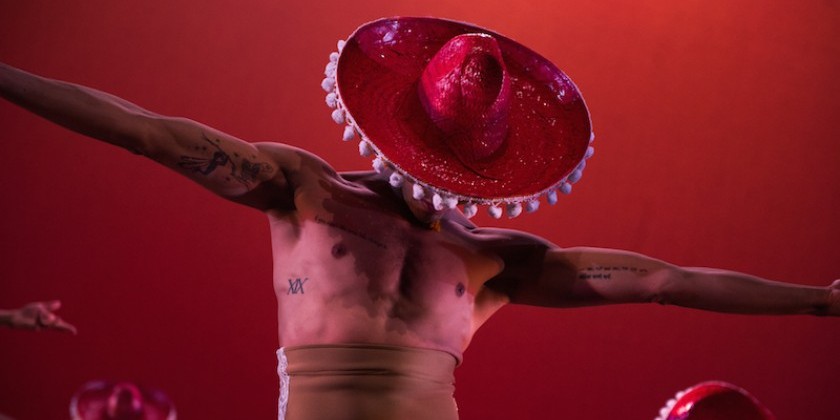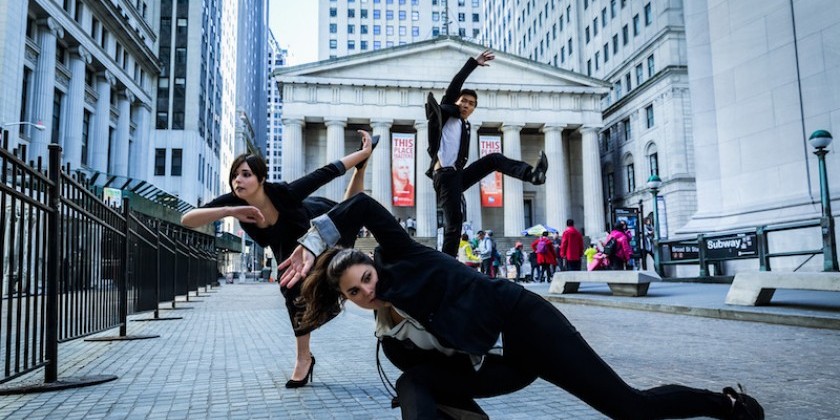IMPRESSIONS: Ballet Hispánico at The Apollo Theater

Ballet Hispánico
December 1 and 2, 2017
Choreography: Ramon Oller, Ronald K. Brown, and Michelle Manzanales
Standing beneath the marquee of the world famous Apollo Theater, I marvel at the line of concert attendees stretching around the avenue. A shell-shocked neighborhood bloke asks, "What are they waiting for? Is Jay-Z here?" No. Tonight Ballet Hispánico returns to Harlem with the promise of fabulous dancers and a grand time. Funnily enough, they also demonstrate a solid case for why women choreographers should receive more commissions. On this three-ballet bill, featuring work by Ramon Oller, Ronald K. Brown, and Michelle Manzanales, it is Manzanales who handily walks away with the show.

Oller's Bury Me Standing describes itself as drawing inspiration from Gypsy culture. Though flamenco music plays throughout, this choreography is more evocative of an old-world European village — any old-world village from anywhere in Europe — with few Roma characteristics. A man dances in defiance of people with their backs turned against him; women scurry on their knees towards the downstage diagonal while jabbering in gibberish; and a procession of men carry their female partners on their backs as if they are crosses. With heavy imagery that fails to develop past its initial impression, it is difficult to understand what Bury Me Standing wants to say. As the work closes, suddenly the entire company invades the stage with charged runs-in-place, casting invisible daggers into the audience, and flicking legs backward into high attitude. With eyes gleaming, the dancers roar out like a beaten people making their last hurrah. Is this the Gypsy inspiration?
Famed for blending folk-forms into technical masterpieces of deep meaning, Ronald K. Brown coasts in Espiritu Vivo offering us a monotonous Spanish-flavored line-dance. This would be appropriate for the 125th Street Block Party, but one expects better of this celebrated man. And though they give it their all, Ballet Hispánico deserves better. What elevates the piece is watching Lyvan Verdecia and Jared Bogart, who steal focus with their emphasis on “getting down low." Consumed by playing with the rhythm, they toss their bodies from one groove to the next, as if this was the greatest party on earth.

Michelle Manzanales' magnificent Con Brazos Abiertos delves into the Mexican-American "identity mambo". Using Diana Winfree as her stand-in, Manzanales unpacks the struggle of being Latina AND American in the United States. Kaleidoscopic configurations comprised of twelve zapateado-stepping amigos dissolve into a tortured solo for Winfree. She throws her head back wearing a sombrero on her neck, or pulls it into her center as if she might slip inside. This conflicted woman is trying to fit in and hide at the same time. A line in the soundscape, from the movie Selena, says it all: "We gotta be more Mexican than the Mexicans and more American than the Americans, both at the same time. It’s exhausting.”
This exhaustion gives way to an exquisite duet between Winfree and Lyvan Verdecia. She nudges him along with her head and shoulders, and though he accepts each step she pushes onto him, he refuses to give her any form of emotional acknowledgment. Spartan and laconic, with a thousand-yard stare, Verdecia is there without being present. Winfree initiates each exchange in this forced, non-reciprocal pas de deux. She basically debases herself trying to get Verdicia to notice her. Perhaps he represents the Latin culture that she doesn't feel a part of.

Unable to elicit the reaction she craves, Winfree lifts Verdecia upon her back as a way of saying, “If I can’t have you, then at least I can hold you.” Finally, he responds; switching places, he perches her on his back in a precarious balance. His reversing places with her is like a father, or any other man, saying, "Listen mija*, I'm never going to smile the way you want me to smile, or say the words ‘I love you.' But I do love you." Perhaps this compromise is the best that a Latina, caught between worlds, can achieve.
Whether the work is middling or brilliant, Ballet Hispánico's dancers look sensational, but it is with Manzanales that the company comes into its own. In recent years, many dance organizations have taken to appointing resident choreographers. With the continued success of Con Brazos Abiertos, and the company's record for supporting female choreographers, one hopes for Manzanales’ appointment to this post.













